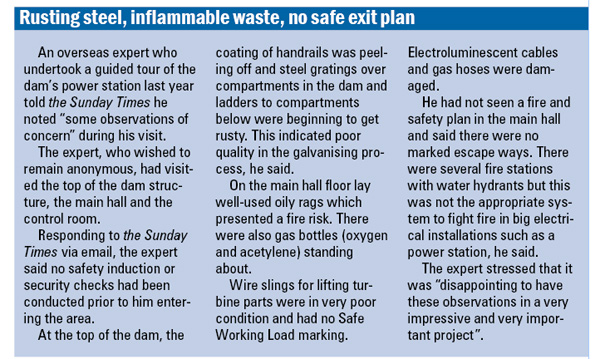News
Water, water everywhere but not for those pushed out of dam’s way
The most ambitious dam project since the Mahaweli programmes of the last century will provide water for drinking, farming and industry across a huge swathe of country including Anuradhapura, Polonnaruwa, Trincomalee and parts of the Central Province – yet those who live closest to it and were displaced to make way for it have no access to its water.
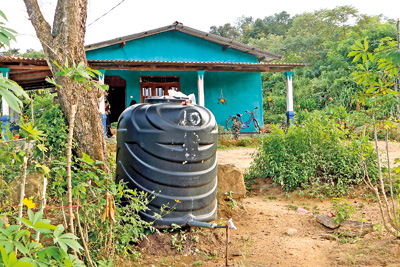
Resettled families must rely on water provided via bowsers by the Mahaweli Authority. The water is collected in tanks such as this one. Pic by Priyantha Samaraweera
Protests over the deprivation have been increasing in recent weeks, with people accusing the new government of reneging on promises.
Once fully complete, the $US770 million Moragahakanda-Kaluganga Multi-Purpose Development Project, which comes under the Mahaweli Authority, is supposed to provide water for 82,000 ha of agricultural land, increase inland fish production by 4,700 metric tonnes, generating Rs. 1 billion in revenue, and supply clean drinking water to thousands.
Villages in 11 grama niladhari divisions went underwater to make way for the construction of the dam. Nearly 3,500 families were displaced over the past eight years.
They were resettled in different places, with some even being given land nearly 70km away in Medirigiriya, Polonnaruwa. Others were settled in nearby areas such as Naula and along the lower valley of the Kalu Ganga.
Many of these families were uprooted from ancestral lands that had been theirs for generations and forced to begin life anew.
“People here didn’t have a drinking water problem before we were evicted, and they were happily farming their own paddy lands,” said R.A.D. Jayatilleke, head of the Moragahakanda People’s Rights Protection Movement.
Mr. Jayatilleke said the authorities had given assurances that those who had been evicted would be provided with means to continue their main livelihood of paddy farming once they were resettled in alternate lands.
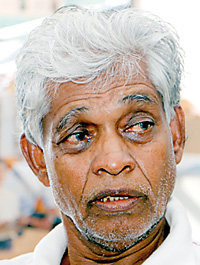
E.M.Kumarasinghe
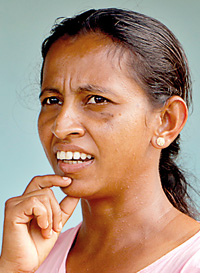
Sandya Kumari Herath
“Yet, nothing much has been done so far. There are no irrigation canals to bring water. How can you farm without water? All we have now is some barren land,” Mr. Jayatilleke said.
Some residents claim they had been given less farming land than they had owned earlier; others, that they had been given land that was uncultivable.
Water for farming purposes is not the only problem: People even lack sufficient water to drink; they have to rely on water supplied from bowsers. sent by the Mahaweli Authority.
From about 2016, the Mahaweli Authority has spent Rs. 900 million a month for providing everything from drinking water, dry rations to even bearing transport costs for the children of displaced families to and from school. The new government has stopped this with effect from January this year, citing a lack of funds.
In mid-February, after several days of protests, leaders of farmers’ associations in the area submitted a memorandum to the Project Director of the Moragahakanda Project, D.B. Wijeratne, calling for immediate measures to resolve issues affecting the resettled families.
Among their main demands are that the government provide water for cultivation in both seasons, as promised, and that it expedite the drinking water project.
The project director informed representatives of the farmers’ associations that water could be provided for those on the project’s left bank for farming purposes by May. Those on the right bank, however, cannot be given water as the company engaged in development work there had suspended construction as the government was yet to settle bills amounting to Rs. 1.1 billion.
“As the company has suspended construction we have no canals or dykes to bring water needed to farm on the right bank. This is yet another tragedy that has befallen us,” Mr. Jayatilleke said.
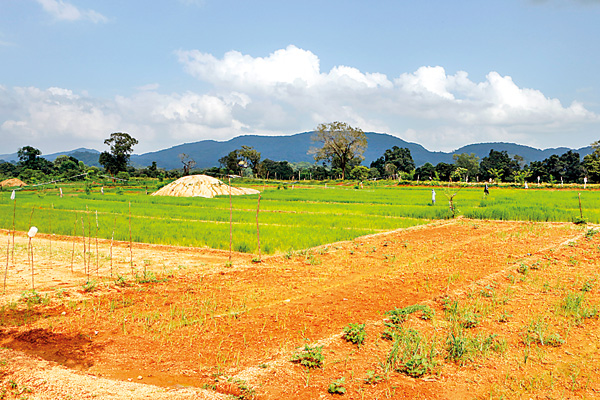
There are no canals to bring water to paddy fields
“Essentially, they are telling us now that the government has no money for projects to give us water to farm or to drink. This is because the political leadership has failed us.”
“This project has been under three presidents: Mahinda Rajapaksa, Maithripala Sirisena and now Gotabaya Rajapaksa. The people here have continued to suffer under all three. We still have no answers. What sort of development are they talking about?.”
In January last year, then President Maithripala Sirisena declared open “Laggala Green Town,” billed as the country’s first town built in an environmentally friendly manner with everything planned to meet the needs of residents.
A total of 23 different government institutions were set up here to help the residents. For all its grandness, though, the town itself has no access to drinking water except through the same bowsers that provide water to the displaced residents.
While in Laggala town, The Sunday Times met several people who had been displaced owing to the Moragahakanda-Kalu Ganga project and were now resettled elsewhere. None of them were happy about their condition.
P.G. Kiribanda, a resident of Narangamuwa village in Matale, had been waiting for more than two hours at Laggala’s new two-storey bus stand for transport.
There was a severe shortage of operational buses. “Only one bus serves my route and it does not even display the route on the front,” Mr. Kiribanda said, also pointing out that the new bus stand did not have seats for the waiting passengers.
“People have made a makeshift bench from stones and a small plank,” he said. The aged and frail and those who are pregnant have nowhere to rest for hours.
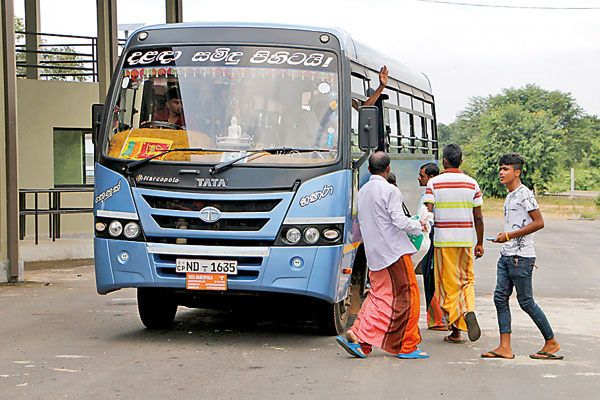
The lone private bus that serves the new Laggala town
He said SLTB buses pass the stand without stopping. Schoolchildren who finish school around 1.30pm have to wait until 2.30pm to get into a bus.
S.A. Kamalawathi, 61, had been a resident of Rawanagama where she had a large property before being relocated to a half-acre plot in Galeyaya with no pipe-borne water.
“They provide us with water from bowsers every day but that water is muddy and tastes bad. We can’t use it even for bathing or washing clothes, let alone for drinking,” she said.
Sandya Kumari Herath, who is also now at Galeyaya, said she had been provided with an acre of farmland ideal for paddy cultivation but was not able to engage in her livelihood because the canals and irrigation works needed for cultivation were yet to be completed.
“They set up small tanks saying those tanks could provide water for farming but the canals have not been dug to channel water to the tanks,” she said.
She also said that school transport had been provided free of charge but now every child had to pay Rs. 40 a day to get a bus to school.
The owner of a grocery near the Laggala bus stand, E.M. Kumarasinghe, 66, said he had been given six perches to re-establish his shop but that he had had to do so using his own money.
“They estimated the value of my original business property at Rs. 3,750 per perch but the six perches I have here are valued at Rs. 1.5 million,” he said.
He has to pay four percent tax for the Rs. 1.5 million worth of land. The tax increases by two percent after two years.
“This town does not have a proper bus service and visitors are few. Even the customers who do come to town don’t buy much stuff, so my business is suffering. I can’t pay such an amount every month with the slim profit I make,” Mr. Kumarasinghe said.
“While saying they are giving us compensation on one hand, they are taxing us on the other to get their money back.” 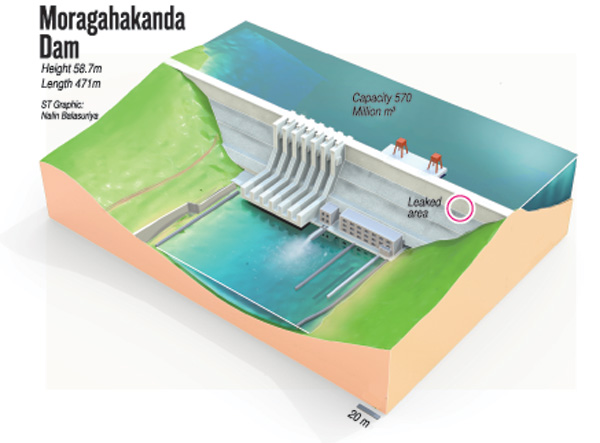
A member of a wildlife management committee in the new Laggala town, who requested anonymity, said nine such committees had been formed in 2015 to protect the newly-created villages from elephants that had themselves been displaced by the dam project.
“The elephants cannot be blamed as people were settled in forested areas that belonged to the Department of Wildlife Conservation (DWC),” the committee member stressed.
He said the DWC had provided a small payment for the committee members and had issued them with crackers to frighten away the elephants. Now, with the committees dissolved, elephants were making their way back to the villages.
The Moragahakanda-Kaluganga Project was included in the master plan of the Mahaweli Development Project as far back as the 1970s.
The project kept being delayed due to the difficulty of obtaining loans to finance it, explained Director Wijeratne. “The benefits of the project are very much long-term. This made it difficult to secure loans,” he said.
That the project went ahead at all was largely due to former president Maithripala Sirisena, who had pushed for it from the time he was minister of agriculture, irrigation and Mahaweli Development under ex-president Mahinda Rajapaksa. His electorate is in Polonnaruwa.
Eventually, that government managed to rope in several different countries to partly finance the project. Loans were obtained from Saudi Arabia ($US61 million), Kuwait ($US45 million) and the Organisation of the Petroleum Exporting Countries, OPEC, ($USD34 million). The China Development Bank provided the biggest loan of $US214 million.
Still, this was far short of the amount needed for the entire project. The balance, amounting to about $US416 million, has been borne by the Treasury.
Additional reporting by Mahesh Keerthiratne and Indika Aruna Kumara
| Dam leak plugged but why did water permeate wall? | |
| While a recent leak in the dam was played down by the authorities and completely plugged, observers say the issue remains a cause for concern. Moragahakanda Reservoir Project Director D.B. Wijeratne said the leak, observed on Christmas Day, December 25, had been completely fixed by January 14. The leak was observed 3-4m below the lip of the dam. 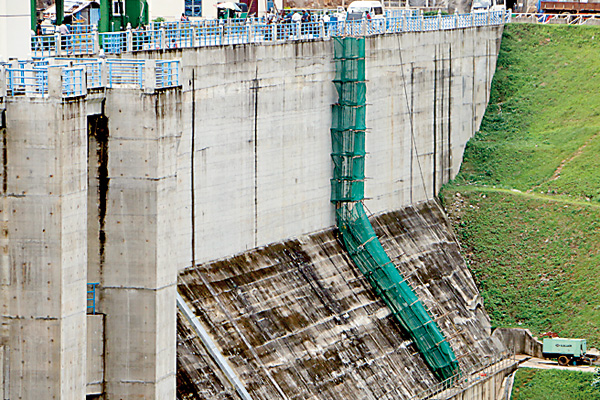 The leak at Moragahakanda dam being plugged A senior engineer who declined to be named but who has years of experience in dam safety, said the leakage itself was not the problem. “All dams leak. Leakage in a dam is not a big thing. The problem here was that this was an unusual leak in that it happened on the downstream face of the dam,” the engineer said. He explained that there are several safeguards in a dam to prevent seepage. The dam has what are known as “galleries”, openings or passageways in the dam’s body that intercept seepage and carry it away from the downstream face. There are also several “waterstops” in copper, rubber and PVC movement joints placed between the concrete building blocks of the 371m-long dam that hold perforated pipes to catch water and send it down to the lowermost gallery and back into the reservoir, the source noted. The size of the leakage was only about 250 litres a minute, which is very little. “The leak, though, should not have come out from this downstream side. It meant there was a path that goes right through the dam for water to seep through,” the engineer said. The senior engineer stressed he did not believe there were any major defects with the construction of the dam. While the Mahaweli Authority has full control of the dam, the project is still under the Defect Liability Period, which means the Chinese contractor, Sinohydro, has to fix any defects at no cost to the Sri Lankan government until June this year. Senior Consultant Engineer of Uma Oya, Nihal Rupasinghe, who also worked as an engineer on dams for over 35 years at the Mahaweli Authority, confirmed the leak had been caused by a construction defect in one of the movement joints designed to absorb heat and earthquake pressures and prevent the concrete cracking. Mr. Rupasinghe said such defects could easily occur at night when the contractors, who often work at night, might have operated in inadequate lighting conditions. He said even a minute misplacement invisible to the eye could create leaks. “If water levels had not been raised to the maximum level the defect would have been undetected,” he said, adding other areas also need to be inspected for defects. Project Director Wijeratne said a team of senior engineers and consultants from the National Building Research Organisation had submitted a report to President Gotabaya Rajapaksa and were due to make a second report. He said the leak had occurred when the dam was filled to maximum capacity for the third time: “It happened when water levels reached 184m above sea level, which is below the maximum water level of 185m”. Mr Wijeratne said some people had presented a wrong picture of what had happened. “If we wanted to cover this up we could have brought the water level down,” he said. “We could have hidden the leak and conducted repairs. Yet we did not do so because this is a normal issue in dams. Such things could even happen in the future.” He dismissed what he said were “silly claims” that there was limestone at the bottom of the reservoir and that there were leakages from the bottom of the dam. He said Sri Lankan engineers had closely inspected every layer of cement used by the Chinese to see whether it met international standards. The reservoir’s Engineer-in-Charge, P.S. Bandara, said the dam had been built with roller-compacted concrete, the first dam to built in Sri Lanka using this method. Explaining the next phase of the project, he said there was a power plant at the base of the dam which would produce 25MW. “We are currently directing water to Elahera Amuna, which provides water to Minneriya, Giritale and Kaudulla tanks,” he added. “Apart from that, the KALUGANGA Project is under construction. Water could be provided to that project as well.” While the leak was being repaired The Sunday Times watched Chinese workers drilling the top portion of the dam to scan for further leakages before carrying out grouting. About 20 Chinese were employed on the job. |
